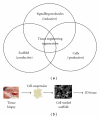Mesenchymal stem cell-based tissue engineering for chondrogenesis
- PMID: 22007146
- PMCID: PMC3191858
- DOI: 10.1155/2011/806891
Mesenchymal stem cell-based tissue engineering for chondrogenesis
Abstract
In tissue engineering fields, recent interest has been focused on stem cell therapy to replace or repair damaged or worn-out tissues due to congenital abnormalities, disease, or injury. In particular, the repair of articular cartilage degeneration by stem cell-based tissue engineering could be of enormous therapeutic and economic benefit for an aging population. Bone marrow-derived mesenchymal stem cells (MSCs) that can induce chondrogenic differentiation would provide an appropriate cell source to repair damaged cartilage tissues; however, we must first understand the optimal environmental conditions for chondrogenic differentiation. In this review, we will focus on identifying the best combination of MSCs and functional extracellular matrices that provides the most successful chondrogenesis.
Figures



References
-
- Griffith LG, Naughton G. Tissue engineering—current challenges and expanding opportunities. Science. 2002;295(5557):1009–1014. - PubMed
-
- Kuo CK, Tuan RS. Tissue engineering with mesenchymal stem cells. IEEE Engineering in Medicine and Biology Magazine. 2003;22(5):51–56. - PubMed
-
- Song L, Baksh D, Tuan RS. Mesenchymal stem cell-based cartilage tissue engineering: cells, scaffold and biology. Cytotherapy. 2004;6(6):596–601. - PubMed
-
- Rose FRAJ, Oreffo ROC. Bone tissue engineering: hope vs hype. Biochemical and Biophysical Research Communications. 2002;292(1):1–7. - PubMed
-
- Patterson TE, Kumagai K, Griffith L, Muschler GF. Cellular strategies for enhancement of fracture repair. The Journal of Bone and Joint Surgery. 2008;90(1):111–119. - PubMed
Publication types
MeSH terms
Substances
LinkOut - more resources
Full Text Sources
Other Literature Sources

